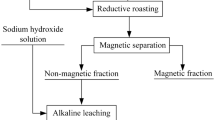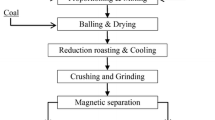Abstract
Pre-reduction is the thermo-chemical beneficiation process which is very useful technique for upgradation of metal values from complex low grade ore. The isothermal reduction behaviour of eastern Indian titaniferous magnetite lump ore without pre-treatment, pre-treated and ore-coke composite briquettes has been investigated in the present study. During pre-reduction of lump ore at 1473 K, magnetite and some part of ilmenite are transformed to metallic iron but most of the ilmenite has not reduced. Pre-treatment by multiple heating to high temperature (1373 K and 1473 K, respectively) and subsequently sudden cooling to room temperature by water successfully increase the porosity as well as many fissures in dense grain, which significantly enhance the degree of reduction. Ilmenite and magnetite phases are transformed to pseudobrookite and hematite during high temperature air soaking, and metallic iron is the dominant phase after reduction. Metallic iron and titanium dioxide are the major phases after reduction at 1373 K, but treatments above 1413 K lead to the formation of ferrous pseudobrookite (FeTi2O5). Finally, the different constitutes are separated by magnetic separation. The phases of reduced pre-treated and briquettes samples cannot be separated by magnetic separation, whereas reduced lump ore is separated successfully. The cause is perhaps due to association and interlocking of high intensity magnetic metallic iron with titanium oxide. Fe:TiO2 is upgraded about to 7.06:1 in the magnetic fraction of reduced lump ore which is formerly 2.14:1 in the case of raw ore. Vanadium is simultaneously distributed at a 3.81:1 ratio in magnetic and non-magnetic fraction.















Similar content being viewed by others
References
R.R. Moskalyk and A.M. Alfantazi, Miner. Eng. 16, 793 (2003).
U.S. Geological Survey Minerals Yearbook Vanadium-2011 [Advance Release] p-80.3.
Y. Wang and Z. Yuan, Int. J. Miner. Process. 81, 133 (2006).
V.E. Roshchin, A.V. Asanov, and A.V. Roshchin, Russ. Metal. 2011, 499–508 (2011).
R.H. Nafziger and R.R. Jordan, Metall. Trans. B 14B, 55 (1983).
M.M. Manamela and P.C. Pistorius, J. South. Afr. Inst. Min. and Metall. 105, 183 (2005).
E. Park and O. Ostrovski, ISIJ Int. 44, 74 (2004).
E. Park and O. Ostrovski, ISIJ Int. 44, 999 (2004).
J. Dang, H. Xiaojun, G. Zhang, X. Hou, X. Yung, and K. Chou, High Temp. Mater. P-Us 0, 1 (2013).
H. Hu, X. Lv, C. Bai, Z. Lun, and G. Qiu, Metal. Mater. Trans. B 44B, 252 (2013).
A.A. Nikolaev, D.E. Kirpichev, A.V. Nikolaev, Y.V. Tsvetkov, and A.A. Morozov, Inorg. Mater: App Re. 2, 224 (2011).
D. Chen, B. Song, L.N. Wang, T. Qi, Y. Wang, and W.J. Wang, Miner. Eng. 24, 864 (2011).
D.Q. Zhu, Y.F. Guo, G.Z. Qui, and T. Jiang, J. Cent. South Univ. Technol. 31, 208 (2000).
T. Hu, X. Lv, C. Bai, Z. Lun, and G. Qui, ISIJ Int. 53, 557 (2013).
S. Samanta, M.C. Goswami, T.K. Baidya, S. Mukherjee, and R. Dey, IJMMM 20, 917 (2013).
A. Saha, S. Ganguly, J. Roy, and A. Dhang, J. Geol. Soc. India 76, 26 (2010).
H.V. Vidyashankar and S. Govindaiah, J. Geol. Soc. India 74, 58 (2009).
D. Beura, D. Acharya, P. Singh, and S. Acharya, J. Miner. Mater. Charact. Eng. 8, 745 (2009).
A. Mehdilo and M. Irannajad, Arab J Geosci. (2012). doi:10.1007/s12517-012-0647-x.
M.A.R. Dewan, G. Zhang, and O. Ostrovski, Metal. Mater. Trans. B 41B, 182 (2010).
W. Yu-ming, Y. Zhang-fu, G. Zhan-cheng, T. Qiang-qiang, L. Zhao-yi, and J. Wei-zhong, Trans. Nonferr. Metal. Soc. 18, 962 (2008).
N. El-Hussiny, J. Ore Dress. 10, 23–29 (2008).
S. Ranganathan, K.K. Bhattacharyya, A.K. Ray, and K.M. Godiwalla, Miner. Process. Extract. Metal. 121, 55 (2012).
Acknowledgement
The authors would like to thank Mr. Supratim Biswas and Mr. Bitan Kumar Sarkar, Research Scholar, Department of Metallurgical and Material Engineering, Jadavpur University, Kolkata. We would also like to express our heartfelt gratitude Mr. S. Bhaduri and Mr. Anirban Sur, Chemist, Geological Survey of India (Eastern Region), Kolkata, (India). One of the authors (S.S.) acknowledges the financial support from Ministry of Steel Development Fund project, Government of India, for funding and providing fellowship.
Author information
Authors and Affiliations
Corresponding author
Rights and permissions
About this article
Cite this article
Samanta, S., Mukherjee, S. & Dey, R. Upgrading Metals Via Direct Reduction from Poly-metallic Titaniferous Magnetite Ore. JOM 67, 467–476 (2015). https://doi.org/10.1007/s11837-014-1203-9
Received:
Accepted:
Published:
Issue Date:
DOI: https://doi.org/10.1007/s11837-014-1203-9




